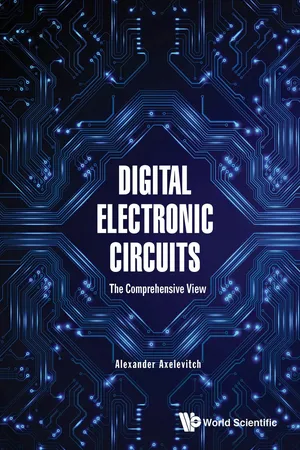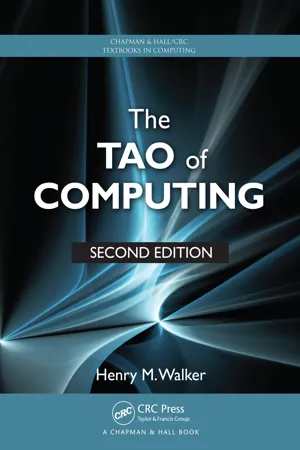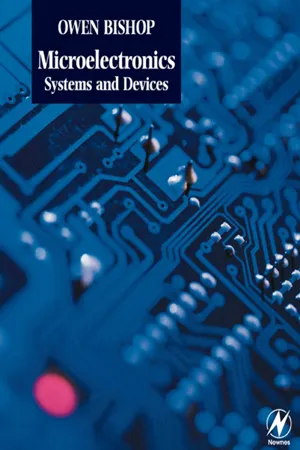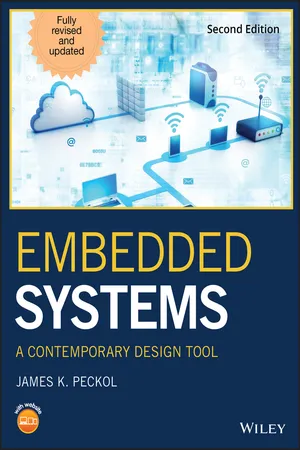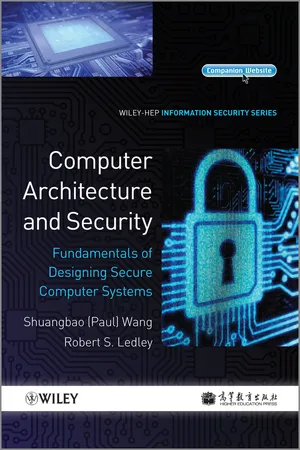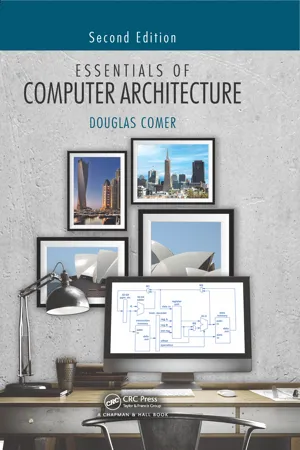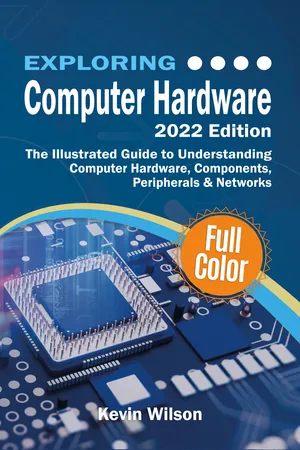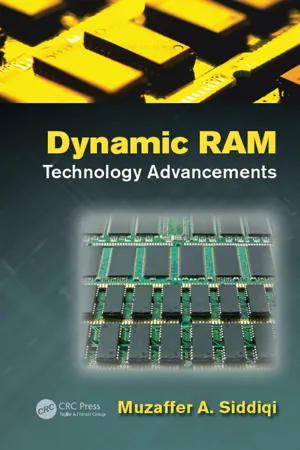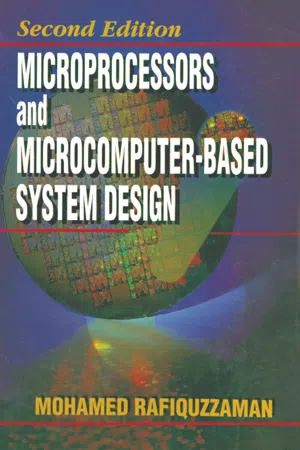Computer Science
RAM and ROM
RAM (Random Access Memory) is a type of computer memory that is volatile, meaning it loses its data when the power is turned off. It is used to store data and machine code currently being used. ROM (Read-Only Memory) is non-volatile memory that retains its data even when the power is turned off. It is used to store firmware and essential system instructions.
Written by Perlego with AI-assistance
Related key terms
11 Key excerpts on "RAM and ROM"
- eBook - ePub
Digital Electronic Circuits
The Comprehensive View
- Alexander Axelevitch(Author)
- 2018(Publication Date)
- WSPC(Publisher)
Semiconductor memory may be divided into three big groups, each one of them used to solve different problems. The first group is the random-access memory or RAM which enables us to store instructions, data, and various constants. The main property of RAM is our ability to access any piece of information stored in memory in the same amount of time independent of its location in memory. Due to the general principle of information storage, each information bit may be stored in two ways. The first method of storage is the application of latch schemes; the second one is the application of a capacitor for this goal. Consequently, all RAM systems are divided into systems that use static random-access memory (SRAM) and systems that use dynamic random-access memory or DRAM. SRAM is built on the base of latch-schemes and capable of storing information for a long time, up to the supply cutoff. DRAM requires a periodic refresh of the stored information due to leakages in the semiconductor capacitors.Fig. 5.8. Two integral circuits produced with an interval of about 30 years between them: the “Fairchild” logic gate consisting of four transistors and two resistors and the Intel-486 microprocessor.Fig. 5.9. A structure organization of the semiconductor memory.The second big group of memories is read-only memory (ROM). ROM is used to store significant information which should be stored without any changes throughout the lifetime of the device. The main operating system of a computer and very important information are usually written in ROM, for example a game which may only be changed with the ROM exchange. The construction of ROM has changed with the development of novel transistor technologies. The first ROMs were programmed with fuses firing in memory; these devices were called PROM. After that, the electrically programmed read-only memory devices (EPROM) were designed. We will discuss the construction of EPROM later. With the goal of changing information in the ROM, erasable devices called EEPROM were designed and applied in industry. - eBook - ePub
- Henry M. Walker(Author)
- 2012(Publication Date)
- Chapman and Hall/CRC(Publisher)
Chapter 1 . Instructions from computer programs and data are stored and retrieved in various locations as needed, and this space is reused as our work moves from one application to another.However, a small area of a computer’s main memory may be predetermined for special purposes. For example, when a computer first starts up, the computer must have preliminary instructions to get started. Also, it may be convenient for certain functions to be wired directly into a section of the main memory. This predetermined memory is called read-only memory (ROM), and its contents are built in when a chip is manufactured; instructions can be obtained from it, but the space cannot be recycled for other uses.A computer owner might encounter ROM when an added capability requires the owner to plug a special chip application directly into the machine. Historically, computer software, such as packages to interpret new computer languages, sometimes was distributed using ROM technology. After buying the new feature, the computer user opened the machine’s cabinet and physically plugged in the ROM chip.Today, modern applications for general-purpose computers typically come on a CD or disk that is not part of the main memory, or software may be downloaded over the Internet, and usage of ROM is more specialized. One area of ROM application may be the distribution of operating systems or games for small, specialized computers. The upgrading of the small computer or the playing of a new game may require the user to plug a chip into the machine.A second common use of ROM technology occurs behind the scenes, and a user may not be directly aware of it. For example, operating systems, such as Linux, Macintosh OS X, or Windows, are large programs that are stored on disks or CDs. Although these provide many services, they require a computer to read the disk or CD. However, when you first turn on a machine, the computer has little knowledge of what to do. It has not had time to read information from a disk; indeed it even needs instruction on how to read a disk! Thus, startup instructions are preprogrammed in ROM. These instructions may include testing some hardware and interacting with a disk to load the basic elements of Linux, Macintosh OS X, or Windows. Such work is possible because the instructions are preprogrammed. Capabilities may be limited (you do not see a fancy windows-based interface when you first turn on a computer), but instructions in ROM allow the computer to start. - eBook - ePub
- Owen Bishop(Author)
- 2013(Publication Date)
- Routledge(Publisher)
The two main types of memory are random access memory (RAM) and read only memory (ROM). Two types of RAM are static RAM (SRAM) and dynamic RAM (DRAM). There are several types of ROM, including mask-programmed ROM, PROM, EPROM and EEROM. Decoders are used to route signals to or from a specified location in memory. A real time clock relieves the CPU of timekeeping duties.There are two main types of memory:- Random access memory – used for temporary storage. Data may be written into it at any time, and later read from it The data is lost when the power supply is switched off. Used for the storage of data and for programs copied from more permanent data stores such as magnetic disks.
- Read only memory – used for permanent storage. In most types, the data once written into it can not be changed. Used for storing programs and data tables.
Random access memory
This occupies most of the available address space in a typical microcomputer. A PC when purchased may be equipped with 32 Mb of RAM, with room for expansion to 64 Mb or more. The RAM is used for the temporary storage of programs and data. There is usually less need for RAM in a microcontroller system, as their programs are permanent and are stored in ROM instead (see below). The RAM is usually included on the microcontroller chip, and may consist of as few as 64 bytes.Mb: the symbol for megabyte, which is approximately one million bytes, but more exactly is 220 , or 1048576 bytes.Whenever data is read from RAM, it is copied in a register of the CPU. Conversely, it is copied from the CPU when it is written into RAM. In either case, the original data remains unaltered after copying. This is known as non-destructive readout.Random access: data may be read from or written to any location at any time. This is different from, say, a shift register, from which data must be read in the order in which it was written.Once data is stored in RAM, it remains there until it is either:- Overwritten and replaced by new data, or
- The power supply is switched off.
Static RAM (SRAM). Each SRAM IC contains an array of flip-flops, each one of which can be set or reset to one of its two states and so represent a logic 0 or a logic 1. The flip-flops may be individually addressable, or they may be addressed in groups of 4 (a nybble) or 8 (a byte - eBook - ePub
Embedded Systems
A Contemporary Design Tool
- James K. Peckol(Author)
- 2019(Publication Date)
- Wiley(Publisher)
dynamic allocation in an embedded context. The topic of memory test closes the chapter. Several approaches for testing RAM and ROM memories are introduced and studied.4.2 Classifying Memory
read only memory, ROMrandom access memory, RAMstatic, dynamicAs a first step in studying memory systems, it is important to recognize that the term memory is generic. There are many different kinds of memory, each with its strengths and weaknesses. Understanding the characteristics of each and how to design with them can lead to more robust and effective design solutions. We begin by classifying memory into two general categories: ROM and RAM. We further subdivide RAM into static RAM (SRAM) and dynamic RAM (DRAM). These classifications lead to a number of different subcategories of both ROM and RAM. Some of the more common subclassifications are described here.- RAM – Random Access Memory. As the name suggests, any location in memory is visible for immediate access rather than having to sequence through predecessor locations. The times for a read operation and a write operation are comparable. A RAM may be organized as bits, bytes, or words.
- DRAM – Dynamic RAM. A simple memory cell design with bit storage implemented using a stored charge mechanism. The stored charge can leak away if it is not repeatedly restored. These devices are used for larger memory systems. I/O is asynchronous with respect to any external system clocks.
- SRAM – Static RAM. A more complex memory cell design with bit storage implemented using a latch‐type mechanism. The stored data does not have to be refreshed. These devices are used for higher speed memory systems because they are faster than DRAM designs. I/O is asynchronous with respect to any external system clocks.
- Semistatic RAM. The periphery is clock activated (dynamic). Only one memory cycle is permitted per clock. The periphery circuitry must be allowed to reset after each active memory cycle for minimum pre‐charge time. No refresh is required.
- SDRAM – Synchronous DRAM
- eBook - ePub
- Shenouda Dawoud, R. Peplow(Authors)
- 2022(Publication Date)
- River Publishers(Publisher)
Nb. This will allow any tables such as truth tables, computer programmes, results or numbers to be stored. In general the table memories are used to store information (data, instructions,…).Function memories store logic functions instead of tables. This type of memories is not the subject of this book and the reader can find many textbox that cover them.We shall limit our discussion to main classes of semiconductor memories: The read-only memory (ROM) and the read-write memory (RWM). The latter is inappropriately called random access memory (RAM). As mentioned before both semiconductor ROM and RWM are random-access devices. Thus, when a RAM is referred to, it is understood that a RWM is being discussed.6.4.1 Read-Only Memory (ROM)
Read-only memory is a non-volatile memory that can be read from, but not written to, by a processor in an embedded or general–purpose system. The mechanism that is used for setting the bits in the memory, is called programming, not writing. For traditional types of ROM, such programming takes place off-line at the factory, when the memory is not actively serving as a memory in a system.Read-only Memory (ROM) cells can be built with only one transistor per bit of storage. A ROM array is commonly implemented as a single-ended NOR array using any of the known NOR gate structures, including the pseudonMOS and the footless dynamic NOR gate. Figure 6.5 shows a 4-word by 6-bit ROM using pseudo-nMOS pull-ups with the following contents:Word 0 : 010101 Word 1 : 011001 Word 2 : 100101 Word 3 : 101010Figure 6.5 Pseudo-nMos ROM.From an engineering point of view, semiconductor ROMs are very easy to use because interfacing ROM to a CPU is even easier than interfacing static RAM. Because the ROM is never written to, a ROM chip requires nothing more than the address of the location to be accessed together with a chip-select signal to operate the output circuits of the chip’s data bus. - eBook - ePub
Computer Architecture and Security
Fundamentals of Designing Secure Computer Systems
- Shuangbao Paul Wang, Robert S. Ledley(Authors)
- 2012(Publication Date)
- Wiley(Publisher)
This is not the same as the mechanisms provided by calls such as mmap and Win32's MapViewOfFile, because inter-file pointers do not work when mapping files into semi-arbitrary places. In Multics, a file (or a segment from a multi-segment file) is mapped into a segment in the address space, so files are always mapped at a segment boundary. A file's linkage section can contain pointers for which an attempt to load the pointer into a register or make an indirect reference through it causes a trap. The unresolved pointer contains an indication of the name of the segment to which the pointer refers and an offset within the segment; the handler for the trap maps the segment into the address space, puts the segment number into the pointer, changes the tag field in the pointer so that it no longer causes a trap, and returns to the code where the trap occurred, re-executing the instruction that caused the trap. This eliminates the need for a linker completely and works when different processes map the same file into different places in their private address spaces.3.5 Non-Volatile Memory
Most computers use random access memory (RAM) as the main memory. RAM is a type of read-write memory that has the fast access speed and can be easily integrated on a large scale. On the other hand, RAM is volatile which means it will lose data once power is removed.Non-volatile memory keeps data even when power is removed. Flash memory and erasable electrically programmable ROM (EEPROM) are non-volatile memories.The author of this book, an engineer at a research institution, invented a flash memory card in 1985, three years earlier than the first commercial flash chip was manufactured by Intel Corporation in 1988 (Non-volatile memory, 1988). The flash memory card was integrated on a standard bus (STD bus) board with digital circuits designed by the author. The technology was tested at a well-known computer corporation and applied to the anti-skip/anti-slide system (now called ABS) for rail trains, a key national science and technology project from 1985 to 1989. A photo of the non-volatile memory card is shown in Figure 3.9 .Figure 3.9 A non-volatile memory card invented in 1985, three years earlier than the first commercial flash chip was manufacturedRead-only memory (ROM) is non-volatile but it cannot be re-written. Programmable ROM (PROM) can only be written once with a special device. Erasable PROM (EPROM) has a window on the chip. Data can be erased by ultraviolet light lasting 20–30 minutes. So it is not considered to be random read/write. Electrically erasable PROM (EEPROM or E2 - eBook - ePub
- Douglas Comer(Author)
- 2017(Publication Date)
- Chapman and Hall/CRC(Publisher)
SSDs ) is nonvolatile — the data stored in the camera or on the disk remains intact when the power is turned off. In fact, data remains even if the storage device is removed from the camera or computer.10.4.2 Memory Access Paradigm
The most common forms of memory are classified as random access , which means that any value in the memory can be accessed in a fixed amount of time independent of its location or of the sequence of locations accessed. The term Random Access Memory (RAM ) is so common that consumers look for RAM when they purchase a computer. The alternative to random access is sequential access in which the time to access a given value depends on the location of that value in the memory and the location of the previously accessed value (typically, accessing the next sequential location in memory is much faster than accessing any other location). For example, one type of sequential access memory consists of a FIFO † queue implemented in hardware.10.4.3 Permanence Of Values
Memory is characterized by whether values can be extracted, updated, or both. The primary form of memory used in a conventional computer system permits an arbitrary value in memory to be accessed (read) or updated (written) at any time. Other forms of memory provide more permanence. For example, some memory is characterized as Read Only Memory (ROM ) because the memory contains data values that can be accessed, but cannot be changed.A form of ROM, Programmable Read Only Memory (PROM ), is designed to allow data values to be stored in the memory and then accessed many times. In the extreme case, a PROM can only be written once — high voltage is used to alter the chip permanently.Intermediate forms of permanence also exist. For example, the flash memory - eBook - ePub
Exploring Computer Hardware
The Illustrated Guide to Understanding Computer Hardware, Components, Peripherals & Networks
- Kevin Wilson(Author)
- 2022(Publication Date)
- Elluminet Press(Publisher)
Computer memory is made up of silicon chips and is the computer’s working area. This is where software instructions and data are stored. This type of memory is known as volatile memory as it requires a power source to maintain the stored data. Once the power is cut, the data is lost.For example if you are typing a document in Microsoft Word, both Microsoft Word and your document are loaded into and stored in the computer’s memory while you are working on it. This is not to be confused with the Hard Disk.DRAM
The first type of RAM we’ll take a look at is DRAM. DRAM stands for Dynamic Random Access Memory and is the memory used to store data in personal computers. DRAM stores each bit of information in a cell composed of a capacitor and a transistor. The transistor admits current to the capacitor during writes, and discharges the capacitor during reads. If there is a charge in the capacitor, it is read as a 1, if there is no charge, it is read as a 0. The capacitor in a DRAM cell can hold a charge for only a few milliseconds, and is said to be ‘dynamic’, because the cell must be constantly recharged (or refreshed) in order to retain its data.SDRAM
The next type of RAM is called SDRAM (or synchronous DRAM). This type of DRAM is called synchronous because its operation is synchronized with an external clock signal (such as the computer’s internal clock). SDRAM uses only the rising edge of the clock signal to transfer data.DDR SDRAM
DDR stands for Double Data Rate and is a memory technology that works by allowing operations to occur on both the rising and falling edge of the clock cycle, thereby effectively doubling the data rate without increasing the clock frequency.The data is stored in memory cells arranged in a grid like pattern called a memory array. The rows are called wordlines and the columns are called bitlines. Each memory array can contain thousands of cells or even millions, but to simplify the design so we can understand what’s going on, we’ll use an 8x8 memory array. - eBook - ePub
Dynamic RAM
Technology Advancements
- Muzaffer A. Siddiqi(Author)
- 2017(Publication Date)
- CRC Press(Publisher)
1 Random Access Memories 1.1 IntroductionThe last few decades have seen a tremendous increase in usage of semiconductor memories, and there has been no looking back. Digital circuits and systems are using semiconductor memories in ever-increasing proportion. Advances in technology and fabrication processes have resulted in a high rate of continuous increase in the memory density. Performance has also been improving, which has opened new application areas considered unreachable. A broad categorization of semiconductor memories is in terms of their ability to retain stored data when supply is stopped; volatile memories lose their data whereas nonvolatile memories retain it. Be it volatile or nonvolatile, in most of the semiconductor memories information can be stored or retrieved from any location, hence the term random access memories (RAMs). The basic arrangement of storage of data/information is done either in a bistable flip-flop called static RAM (SRAM) or through charging a capacitor in dynamic RAM (DRAM). Both SRAM and DRAM are volatile memories.In the last four decades SRAM and DRAM have seen tremendous growth. Both have been developed, improved, and used in large quantities. However, in terms of volume, DRAMs have remained on top as main memory in large systems, apart from other widespread applications, because of their higher density and low cost per bit of information stored. At the same technology generation level, SRAM occupies nearly four times the chip area of DRAM, but it is faster and has low power consumption. Therefore, DRAM designers continuously try to make it faster as well as better in terms of power consumption.The basis entity in a semiconductor memory is a cell in which a bit of information is stored. SRAM employs six or four transistors in each cell and the DRAM uses a single transistor, called access transistor, and a small value capacitor, called storage capacitor. Since the cell has to be replicated as many times as the density of the RAM, all efforts are concentrated toward the improvements in the formation of cell, or on the access transistor and the storage capacitor. This book is intended to be a study on important technological aspects of the single-transistor single-capacitor (1T1C) DRAM. As the DRAM evolved from the six-transistor SRAM through reduction in the use of number of transistors, Chapter 1 begins with a brief introduction of the construction and working of SRAM. Changeover to three-transistor (3T) DRAM, along with its basic operation and construction, is taken next and then its conversion to the (1T1C) DRAM, which enabled it to be produced in 4 Mbit and 16 Mbit density levels. Early-stage DRAM cell was a simple entity with a planar metal-oxide-semiconductor field-effect transistor (MOSFET) and a planar capacitor fabricated side by side. Its major difference with the 3T DRAM was that the retrieving of information or read operation became destructive in the DRAM. It became a must to restore the information in each cell of the DRAM, which was done through a sense amplifier. It was and shall remain one of the most important peripheral circuits for the DRAM cell operation. While using the sense amplifier, reduction in the generated noise was to be minimized and one of the early methods, which is continuously in use, is folded bit-line connection in place of open bit-line configuration - eBook - ePub
Computer Architecture
Fundamentals and Principles of Computer Design, Second Edition
- Joseph D. Dumas II(Author)
- 2016(Publication Date)
- CRC Press(Publisher)
erasable/programmable read-only memories (EPROMs), are roughly comparable to SRAM in cost and density although they generally operate at DRAM speeds or slower. They are nonvolatile but have the major limitation of not being writable (although EPROMs can be reprogrammed in a separate circuit after erasure with ultraviolet light). Because they are not read/write memories, ROMs are only useful in limited applications, such as single-purpose embedded systems, video game cartridges, and the basic input/output system (BIOS) that contains the bootstrap code and low-level input/output (I/O) routines for most typical computer systems.Semiconductor “read-mostly” memories include electrically erasable programmable read-only memories (EEPROMs) and their technological descendants, flash memories . These memories are nonvolatile, but unlike ROMs, they are rewritable in-circuit. Writes, however, can take significantly longer than reads to perform and in some cases must be done as “block” writes rather than individual memory locations. Also, these devices are more expensive than most other semiconductor memories and can only be rewritten a limited number (usually a few tens or hundreds of thousands) of times, so they are not suitable for populating the entire main memory space of a computer. Instead, read-mostly memories are typically used for special-purpose applications, such as digital cameras, portable thumb drives, hybrid drives, tablet computers, and smartphones.Magnetic memories have been in use much longer than semiconductor memories—almost as long as there have been electronic computers. Mainframe computers of the 1950s often used rotating magnetic drums for storage; a few years later, magnetic core memory became the standard technology for main memory and remained so until it was replaced by integrated-circuit RAM and ROM in the 1970s. Magnetic core memory, like all magnetic memories, offered the advantage of nonvolatility (except in the presence of a strong external magnetic field). Access times were on the order of microseconds, however, and so this technology fell out of favor when faster semiconductor memories became cost-competitive. Another related (but slower) technology, magnetic bubble memory - Mohamed Rafiquzzaman(Author)
- 2021(Publication Date)
- CRC Press(Publisher)
In an EPROM, programs are entered using electrical impulses and the stored information is erased by using ultraviolet rays. Usually an EPROM is programmed by inserting the EPROM chip into the socket of a PROM programmer and providing program addresses and voltage pulses at the appropriate pins of the chip. Typical erase times vary between 10 and 30 minutes.With advances in IC technology, it is possible to achieve an electrical means of erasure. These new ROMs are called Electrically Alterable ROMs (EAROMs) or Electrically Erasable PROMs (EEPROMs or E2 PROMs) and these ROM chips can be programmed even when they are in the circuit board. These memories are also called Read Mostly Memories (RMMs), since they have much slower write times than read times. Random Access Memories (RAMs) are read/write memories.Information stored in random access memories will be lost if the power is turned off. This property is known as volatility and, hence, RAMs are usually called volatile memories. RAMs can be backed up by batteries for a certain period of time and are sometimes called nonvolatile RAMs. Stored information in a magnetic tape or magnetic disk is not lost when the power is turned off. Therefore, these storage devices are called nonvolatile memories. Note that a ROM is a nonvolatile memory.Some RAMs are constructed using bipolar transistors, and the information is stored in the form of voltage levels in flip-flops. These voltage levels do not usually drift away, or decay. Such memories are called static RAMs because the stored information remains constant for some period of time.On the other hand, in RAMs that are designed using MOS transistors, the information is held in the form of electrical charges in capacitors. Here, the stored charge has the tendency to decay. Therefore, a stored 1 would become a 0 if no precautions were taken. These memories are referred to as dynamic RAMs. In order to prevent any information loss, dynamic RAMs have to be refreshed at regular intervals. Refreshing means boosting the signal level and writing it back. This activity is performed by a hardware unit called “refresh logic” which can either be a separate chip or is contained in the microprocessor chip.
Learn about this page
Index pages curate the most relevant extracts from our library of academic textbooks. They’ve been created using an in-house natural language model (NLM), each adding context and meaning to key research topics.
